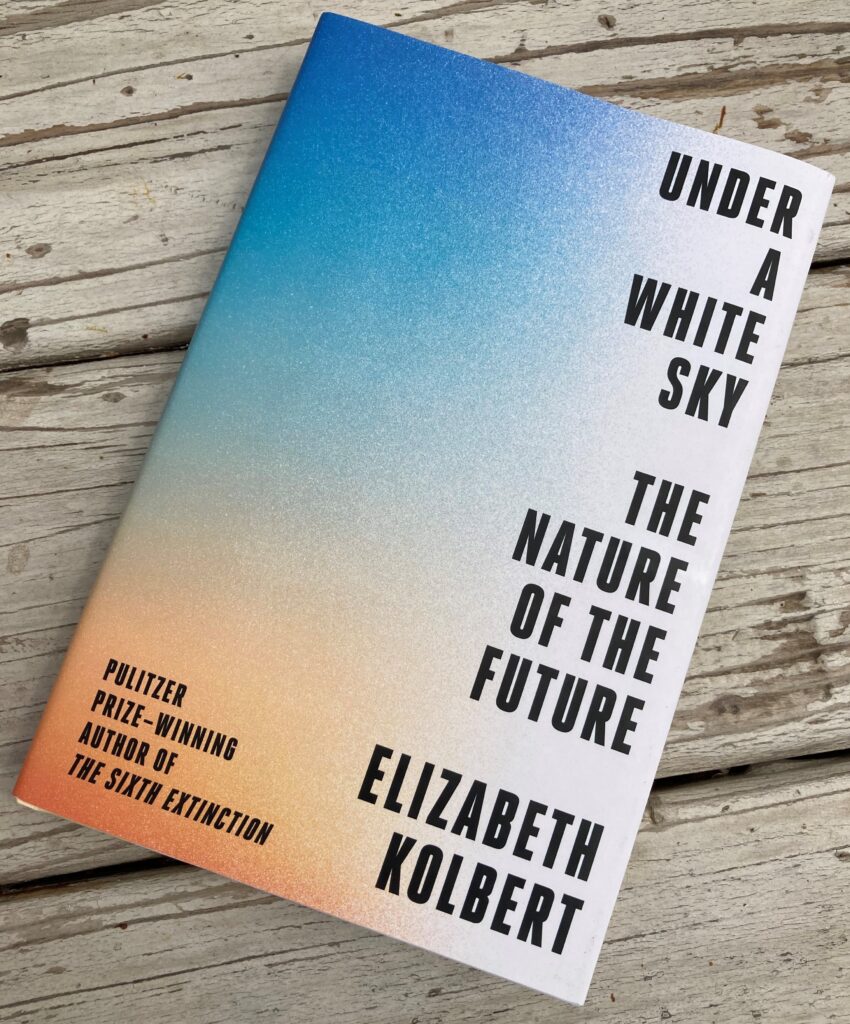
The Anthropocene Epoch is an unofficial unit of geologic time, used to describe the most recent period in Earth’s history when human activity started to have a significant impact on the planet’s climate and ecosystems.*
Mankind has transformed the planet. While problems have been solved and life made more comfortable for many, these achievements are often fraught with unintended consequences.
This is the subject of Pulitzer Prize winner Elizabeth Kolbert’s Under a White Sky: The Nature of the Future, which she describes as “a book about people trying to solve problems created by people trying to solve problems.” Think of the last time you didn’t call the plumber.
Case in Point: Over one hundred years ago, the flow of the Chicago River was reversed. This engineering feat re-routed the effluence of the rapidly growing city—“the human excrement, the cow manure, the sheep dung, the rotting viscera from stockyards” —which had previously flowed into the city’s source of fresh water, Lake Michigan. Instead, this toxic brew was floated south to the Des Plaines River, the Mississippi and eventually, the Gulf of Mexico.
I’m reminded of the warning to avoid drinking water in the backcountry without purifying it first. You just never know what the people and animals upstream might be doing with it; unlike those in St. Louis who knew exactly what Chicago was doing with it.
Anyway, linking the Great Lakes with the Mississippi via the Sanitary and Ship Canal—aka the Oversized Sphincter—created a waterway between previously separated eco-systems and, in the process, “upended the hydrology of roughly two-thirds of the United States.”
We continue to deal with sphincter-related problems. Following the passage of the Clean Water acts of the 1970s, Asian carp were introduced into the Mississippi in hopes that these voracious fish would devour algae, weeds and other river stuff that gets in the way of making water suitable for human use.
As it turns out, these massive fish can completely overwhelm native plants and other species. They sometimes grow to one hundred pounds and, when spooked, can jump up to nine feet out of the water; occasionally concussing unwitting jet-skiers and breaking the bones of fishermen.
You’ll understand then why those near Lake Michigan are a bit worried that a few of these carp might find their way into the Great Lakes; and can hardly blame those in St. Louis for grinning at this one.
As Asian carp threaten waterways throughout the United States, cane toads are wreaking havoc in Australia. In 1935, 101 cane toads were introduced to eat beetle grubs that devastate sugar cane crops. It took only a single year for them to lay “more than 1.5 million eggs” which are found in long gelatinous strands resembling a necklace of black beads.
Problem is, cane toads are toxic. The poison, found in glands behind the shoulders, has been ingested by many creatures up and down the food chain. Species decimated by this “anthropo-led” invasion include freshwater crocodiles, monitor lizards, several types of snakes, and a “sweet-looking” marsupial, the northern quoll.
Today, these “disturbingly large” toads have expanded their territory and are projected to one day inhabit nearly the entirety of Australia’s coastal areas. Adding insult to this grievous ecological injury, cane toads are completely ineffective at protecting sugar cane.
While early attempts to rid Australia of cane toads included Outback-worthy methods using hammers and golf clubs, and the formation of “cane toad militias,” current tactics include altering their DNA to make them less toxic. Scientists also hope to tweak a gene to facilitate passing the alteration to an entire population of toads.
With all this genetic tinkering, it seems only fitting that one of the areas threatened by these creatures is Darwin in Australia’s Northern Territory.
Speaking of Charles Darwin; the On the Origin of Species author contended that evolution proceeds so slowly it can’t be seen. Another group of scientists in Australia are challenging that contention.
Warming ocean water and ocean acidification have devastated the Great Barrier Reef off the northeastern coast of the island continent. This on-going disaster is marked by a rapid decline in the plant-like animals that define and sustain it—coral. Fully aware that the oceans aren’t going to be cooling down any time soon, scientists are now experimenting with the “assisted evolution” of coral.
While much of the 1400 mile collection of reefs has died out, some types of coral have survived. Scientists gather survivors from different parts of the reef and then cross breed them in the lab. The cool part—for the scientists, not so much the coral—is that they then subject these offspring to “calibrated stress” which kills some but not all. The survivors are then bred and stressed again. The resulting heartier coral are hoped to be used to “re-seed” the reef with “super-coral” which can thrive in a warmer ocean.
Sadly, the survival-of-the-fittest coral reminds me of modern human communities who either can or cannot deal with the effects of climate change. The unpleasant truth is that our changing planet will likely be catastrophic only for some of us.
Other “problem-solution-problem” adventures in this wonderfully entertaining and informative book deal with re-directing the Mississippi River so that it will do what it did before levees were built; artificially maintaining a small population of pupfish who are found only in a single pool of water in the middle of the desert; altering mice so that all offspring are male; and physically removing carbon from the atmosphere by solidifying it and then putting it back into the earth. As Kolbert asks, “What could possibly go wrong?”
*To those who have any remaining doubt as to the hard truth of anthropogenic climate change, your view is no longer a rational opinion about which we can simply agree to disagree. If you can muster the courage to confront the error of your ways, here’s a site that blows up all that disinformation you’ve been consuming.
Anthropocene definition found here: https://www.nationalgeographic.org/encyclopedia/anthropocene/











